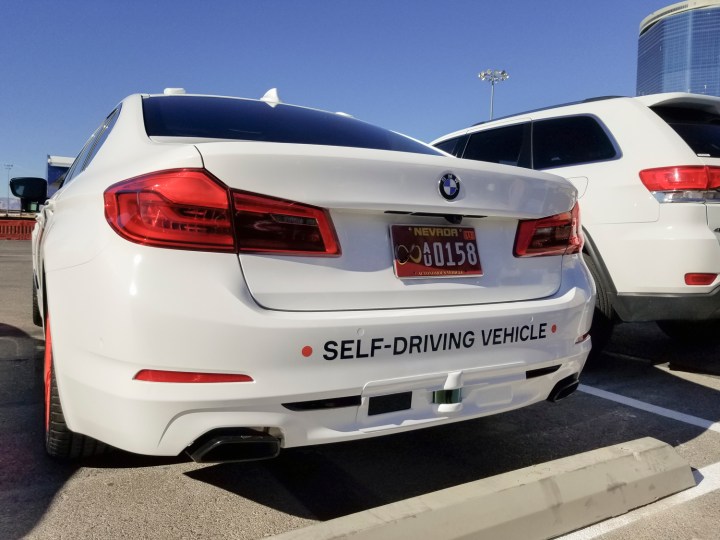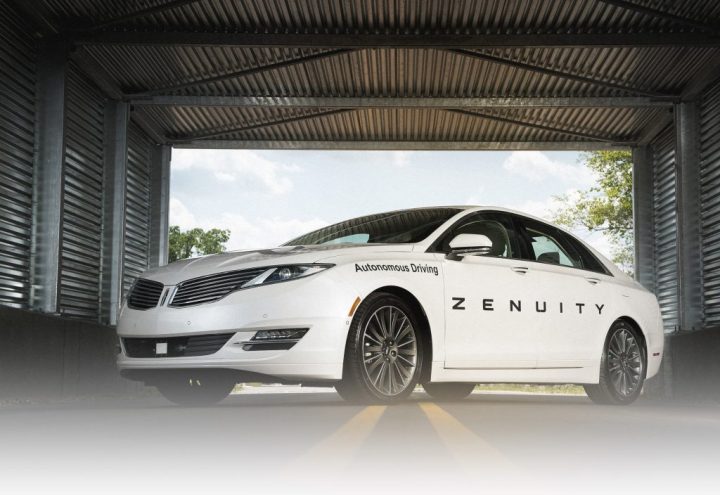
At CES, car and gadget makers alike are showing off their wares and demonstrating the autonomous cars of the future. We set out to create a comprehensive who’s who of the space to show the breadth and scope of what’s happening — but it’s simply impossible.
Dozens of technology and car companies big and small have designs aimed at self-driving cars
For example, there must be a dozen companies showing off Lidar systems – those are the eyeballs for cars that let them drive themselves. A group called 6th wants to make Lidar systems for motorcycles, Benewake plans to make solid-state lidar detectors with fewer moving parts, and TriLumina makes “3D solid-state lidar,” which probably is an improvement over non-3D, non-solid state systems, but we’ll be damned if we know just how.
Then there’s a fleet of companies with new interfaces to facilitate how you interact with your car (human-machine interaction, or HMI – because, of course, there’s an acronym), as well as a small armada working on automotive-grade Linux, which pretty much everyone seems to think is going to be at the heart of every self-driving vehicle someday. Sorry, Windows.
Anyway, here’s a sorta-maybe comprehensive look at who’s who in this brave new world.
AImotive

With tens of millions of dollars in the bank and big ambitions, AImotive has developed proprietary autonomous driving capabilities with cheap components – off-the-shelf cameras and that sort of thing. But it’s legit: The company has received autonomous testing licenses on public roads for multiple locations, including Hungary, France, and California. It plans to further expand testing to Japan and China, as well as other U.S. states, in 2018.
Aptiv

Here’s a name you don’t know but should get familiar with. Aptiv was once part of Delphi, which was itself once part of GM, and is probably the biggest name in automotive components. Working with Lyft, Aptiv is taking journalists on rides in self-driving cars here at CES. The vehicle and automated technology is Aptiv’s, whereas the consumer platform/app is developed by Lyft.
Argo.ai

Argo has a helluva pedigree: founders Bryan Salesky (who now serves as the CEO) and Peter Rander (chief operating officer) formerly led the self-driving car teams at Google and Uber, respectively. No wonder Ford announced a $1 billion investment in Argo about a year ago. The goal: to “develop a new software platform for Ford’s fully autonomous vehicle coming in 2021.”
Aurora

What would happen if the smartest people from Google, Tesla, and Uber decided to leave the big giants and set out on their own? Aurora would happen – and the secretive startup just unveiled plans to work with Hyundai and Volkswagen on autonomous cars.
Baidu

The Chinese search engine giant wants to expand its reach into autonomous vehicles, and has several big announcements planned for CES 2018. This year, they’ll be showing off Apollo 2.0 — the latest iteration of Baidu’s open, autonomous driving platform – as well as Apollo Pilot, Baidu’s solution for L3 autonomous driving.
Cisco

The name Cisco is synonymous with networks – and guess what’s in every car these days? Really, really complicated networks, on a slew of aging wiring protocols. Like every company everywhere, Cisco views the automotive space as a bajillion-dollar opportunity. Expect to hear from them at CES.
Clarion

You may know the name Clarion based on its few decades of work in car stereos. The company, a subsidiary of Hitachi, actually makes a boatload of software that goes into cars as well. To make sure everyone’s aware of that, Clarion will be showcasing and providing real in-car demonstrations of its next-generation autonomous driving technologies at CES, including autonomous valet parking.
Green Hills Software

Green Hills Software sees a future in self-driving cars; at CES the company is partnering with microcontroller maker Renesas Electronics to show off a demonstration platform that includes everything BUT the actual “driving the car” part. Called the Connected Cockpit Vehicle, it does navigation, multimedia, control of your A/C, the interaction between you and car, and more. It also just sounds neat.
Intel

You can’t have a list of emerging tech stuff and not see Intel somewhere on it. Intel is betting on automotive-grade Linux, and is doing serious work to make this a reality. At CES, Intel’s Transport Division will demo an auto reference platform, and in general, they’re working with anyone and everyone to facilitate it, touting partnerships at CES 2018 with BMW, Nissan, SAIC Motor, Volkswagen, and Ferrari North America.
Navya

We hate the name, which sounds like something a New York cabbie would say to you around a cigar (“Navya to Rockefeller Centah? You got it!”). But Navya is one company actually doing, not just talking. The French company makes the self-driving shuttle busses that are tootling around Las Vegas, including the one that made international headlines in November for an eensy-weensy crash. This year, Keolis and Navya will be showing off autonomous robotaxis (which sounds like the same thing).
NuTonomy

It builds the software that lets self-driving cars drive. Nutonomy was acquired by Aptiv recently.
Nvidia

Nvidia was once just a graphics giant. No more. The company has reinvented itself, expanding into a number of areas, including machine vision. We learned last year of Nvidia’s autonomous vehicle partnership with Audi. Expect big news this year.
Qualcomm

Qualcomm isn’t making self-driving cars. But like Intel and Nvidia, the chip giant is making it all possible, and leading the charge at CES 2018. One specialty: Vehicle-to-everything communications, thanks to
Renesas Electronics

Semiconductor manufacturer Renesas has been around since 2010; at CES 2018 the company partnered with half a dozen names on this list to show off three self driving vehicles: a Cadillac SRX and a Lincoln MKZ from years past (with some upgrades, we hear), and a RAM 1500 truck with a new vision of what the cockpit of the future will look like.
Transdev

It’s not just U.S. engineers working on self-driving cars, of course. French company Transdev recently launched the Rouen Normandy Autonomous Lab project, Europe’s first autonomous electric vehicles available for public use. And just to make sure you’re aware, they’re going to have the vehicles at CES.
Torc

Torc is a robotics company that claims to have “one of the oldest self-driving car teams developing autonomous technology today.” The Asimov self-driving system by Torc was jumpstarted back in 2007 with a third-place win in the DARPA (Defense Advanced Research Projects Agency) Urban Challenge, a road race testing self-driving vehicles. At CES, they’re showing off a complete self-driving car.
Waymo

Actually, we don’t think Waymo’s here at all. But the Google spinoff was clearly among the first to put self-driving cars on the map.
The University of Waterloo

Who? I know. The school will be at the 2018
Zenuity

Last year at CES, Volvo and Autoliv teamed up to launch Zenuity. In June, the duo were joined by Nvidia, which signed an agreement to power the platform. And at CES 2018, TomTom joined the party with its HD mapping technology. The cars of the future are just around the corner, it seems!







